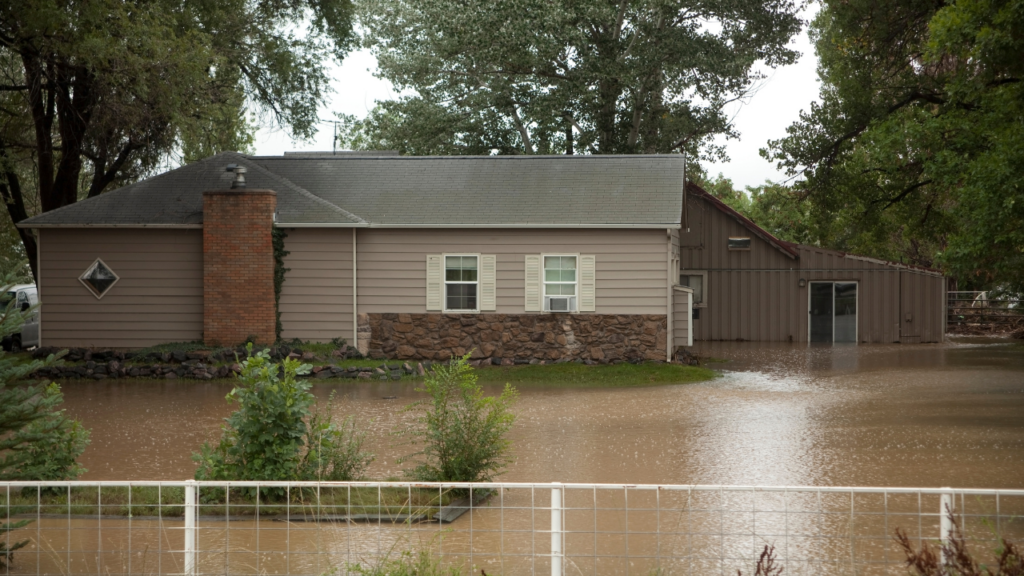
Cleaning the Kitchen After a Flood
Flood water can bring in silt, raw sewage, and chemical waste into your home. Before cleaning and repair, ensure you have taken photos of the flood damage to provide to your insurance agent. Here are steps to take to return your kitchen back to a safe place to prepare food.
Discarding & Saving Food
Do NOT save or eat any food that may have come into contact with flood water.
Discard these items if contaminated by flood water:
- Any foods or beverages that are not in a waterproof container including screw-caps, snap lids, pull tops, and crimped caps.
- Staples in canisters (flour, sugar), and home canned items. Seal on home canned items may not be adequate to prevent contamination.
- Throw out dented, leaking, punctured, bulging or rusted canned foods.
- Foods in cardboard boxes and/or cardboard seals, food in glass jars or those with wax paper, foil, cellophane or cloth.
Cleaning Waterproof, Undamaged Cans, Retort Pouches
Undamaged, commercially prepared food stored in all-metal cans or in “retort pouches” (like flexible, shelf-stable juice or seafood pouches), can be saved by following the cleaning steps below. Only use water from a safe source for drinking, washing, or preparing food. If unsure, use bottled water.
- Step 1: Mark contents on lid with ink that cannot be erased, removed, or washed out.
- Step 2: Remove labels if possible. They can harbor dangerous bacteria.
- Step 3: Wash cans or pouches in a strong detergent solution with a scrub brush.
- Step 4: Immerse in 1 tablespoon of unscented chlorine bleach per a gallon of room temperature water for 15 min.
- Step 5: Air dry for an hour before opening or storing. Use as soon as possible.
Cleaning Utensils, Equipment, & Countertops that Come in Contact with Flood Water
Discard containers, dishes, and utensils that are made of porous materials that can absorb water such as wooden cutting boards. Discard plastic utensils, baby bottle nipples, and pacifiers. There is no safe way to clean them.
Metal, Glass, or Ceramic Pots, Dishes, Glassware & Utensils (including can openers)
- Wash with soap and water (hot water if available). Rinse and sanitize them by boiling in clean water or completely immersing them for 15 minutes in a solution of 1 tablespoon of unscented, liquid chlorine bleach per gallon of potable water. Don’t forget to remove any detachable parts.
Countertops
- Wash countertops with soap and water (hot water if available). Rinse and then sanitize them by applying a solution of 1 tablespoon of unscented, liquid chlorine bleach per gallon of drinking water. Allow to air-dry.
Appliances and Electrocution Risks
- Do not touch electrical equipment if it is wet or if you are standing in water. If it is safe to do so, turn off the electricity to prevent electric shock.
- Electrical appliances submerged in floodwater are often not repairable. If your refrigerator or freezer was submerged by floodwaters — even partially —it is recommended to discard.
Preventing Mold Growth
- Flood damage can lead to the formation of mold spores in the kitchen. To reduce mold inside your home:
- Clean and dry any damp or flooded materials and furnishings
- Decrease the humidity in your house with fans and de-humidifiers
- Porous materials like carpets and drywall will have to be replaced if they become moldy, hard non-porous surfaces can sometimes be cleaned of mold growth
- Antimicrobial products should have an EPA Registration number and be designed specifically for your situation. Follow all label directions carefully.


